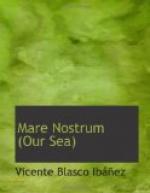Below these transparent and ethereal forms that burn whatever they touch, venturing to capture prey much larger than themselves, were grouped as in gardens the so-called “flower of blood,” the red coral, and especially the star-fish, forming with their corolla an orange-colored ring.
The captain had seen these stony vegetations, like submerged groves, in the depths of the Dead Sea and also in the southern seas. He had sailed over them under the illusion that through the bluish depths of the ocean were circulating broad rivers of blood.
The oseznos (bear-cubs) and the star-fish were slowly waving the forms that had given rise to their names, secreting poisons in order to paralyze their victims, contracting themselves until they formed a ball of lances that grasped their prey in a deadly embrace or cut it with the bony knives of their radiating body. The iris of the sea balanced themselves on end, moving their members as though they were petals.
Upon the fine sandy depths or attached to the rocks, the mollusks lived in the protection of their shells.
The necessity of giving themselves up to sleep with relative security, without fear of the general rapacity which is the oceanic law, is a matter of concern to all of these marine beings, making them constructive and inventive. The crustaceans live within their shells or take advantage of ready-made refuges of limestone, expelling their former owners; the animal-plants exhale toxins; the planctonic beings, transparent and gelatinous, burn like a crystal exposed to fire; some organisms apparently weak and flabby, have in their tails the force of a carpenter’s bit, perforating the rock sufficiently to create a cavern of refuge in its hard interior.... And the timid mollusks, trembling and succulent pulp, have fabricated for their protection the strong shields of their valves,—two concave walls that on opening form their door, and on closing, their house.
A bit of flesh protrudes outside these shells, like a white tongue. In some it takes the form of a sole, and serves as a foot, the mollusk marching with his dwelling upon the back of this unique support. In others it is a swimmer, and the shell, opening and shutting its valves like a propelling mouth, ascends in a straight line to the surface, falling afterwards with the two shields closed.
These herbivorous fresh-water animals live by drinking in the light,—feeling the necessity of the surface waters or the shallow depths with their limpid glades—and this light, spreading over the white interior of their dwelling, decorates it with all the fleeting colors of the iris, giving to the limestone the mysterious shimmer of mother-of-pearl.
Ulysses admired the odd forms of their winding passageways. They were like the palaces of the Orient, dark and forbidding on the outside, glistening within like a lake of pearl. Some received their terrestrial names because of the special form of their shell—the rabbit, the helmet, triton’s horn, the cask, the Mediterranean parasol.




